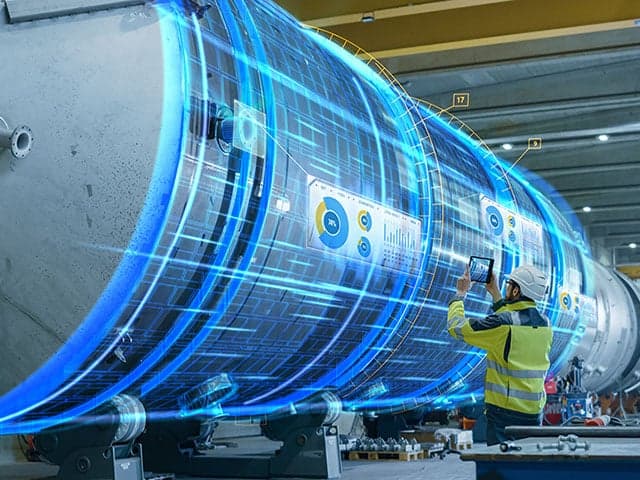Computer Vision Services
Transform your quality control and inspection processes with Element’s Computer Vision Services. Our machine-learning solutions automate defect detection, object classification, and predictive maintenance, outperforming human inspection with consistent accuracy and scalability. Integrate AI-driven image analysis into your operations to enhance safety, boost productivity, and drive digital transformation.

What is Computer Vision at Element?
Computer vision harnesses machine learning technology to extract meaningful insights from digital images and video streams. At Element, we specialize in industrial applications of this technology, from production line monitoring to computed tomography (CT) and non-destructive testing (NDT) analysis. Our solutions automate visual inspections, defect detection, and object classification, providing consistent, scalable, and reliable quality control that outperforms manual inspections.

What can Element offer you for computer vision services?
Components and materials we test
Components and materials we test
Elements' computer vision solutions analyze visual data across multiple industrial applications, including computed tomography (CT) scans, non-destructive test (NDT) images, production line components, railway track infrastructure, and manufacturing defects. Our AI-powered models deliver comprehensive defect detection and quality control.
Key services offered
Key services offered
We provide classification, object detection, semantic segmentation, and object tracking solutions, powered by Bayesian Inference and advanced machine learning techniques. Our services enable automated visual analysis for quality control, safety monitoring, and predictive maintenance.
Cutting-edge equipment we use
Cutting-edge equipment we use
Our advanced computing infrastructure supports machine learning, AI-driven modeling, and high-performance simulations. We integrate with industrial imaging systems, including computed tomography (CT) scanners and non-destructive testing (NDT) equipment, ensuring validation of digital models against real-world data.
Which labs offer this service
Which labs offer this service
Our Bristol, Derby, and Houston digital engineering hubs provide global access to our expert capabilities. Find out where your nearest digital engineering hub is on our Locations Page.
Advanced mathematical capabilities
Advanced mathematical capabilities
Our computer vision solutions are enhanced by Bayesian Inference modeling, a sophisticated mathematical approach that continuously updates and improves model hypotheses based on new data observations. This underpins our generative models and machine learning techniques, ensuring increasingly accurate results over time.
Products we test
- Assembly line components
- Railway track infrastructure
- Production line equipment
- Non-destructive test images
- Computed tomography scans
- Industrial machinery
- Manufacturing defects
- Infrastructure elements
Your Challenges, Our Solutions
Manual Inspection Limitations
Safety and Risk Management
Productivity Bottlenecks
Accuracy and Reliability Issues
Element Experts at your service
Lorem ipsum dolor sit amet, consectetur adipiscing elit, sed do eiusmod tempor incididunt ut labore et dolore magna aliqua
Why Choose Element

Global Expert Network
Advanced Technical Capabilities
Comprehensive Digital Integration
Industrial Specialization
Frequently asked questions
What types of computer vision tasks can Element perform?
We specialize in classification (identifying objects or defects), object detection (locating specific items in images), and semantic segmentation (detailed image analysis), along with derived tasks like object tracking.
How does Element use Bayesian Inference in computer vision?
We incorporate Bayesian Inference in our generative models to continuously update and refine our machine-learning techniques. This mathematical method allows our models to learn from each new observation, improving accuracy and reliability over time.

Explore our global network of labs and find your nearest location
VIEW ALL LOCATIONSRelated services

Digital Engineering Services
Element's Digital Engineering Services enhance reliability, reduce costs, and accelerate innovation through advanced simulations and data-driven insights. Our customized solutions streamline project lifecycles, ensuring optimized designs, regulatory compliance, and future-ready technology.

Computational Fluid Dynamics
We use Computational Fluid Dynamics (CFD) to simulate and analyze complex problems involving fluid-fluid, fluid-solid, and fluid-gas interactions.

Digital Twin Solutions and Services
Enhance efficiency with our Digital Twin Solutions. Predict performance, reduce costs, and optimize operations with real-time virtual replicas of your assets.

Discrete Element Method (DEM) Services
Model particle interactions, optimize processes, and improve equipment performance with our Discrete Element Method (DEM) services. Maximize efficiency today.

Machine Learning and Data Science Services
Our Machine Learning and Data Science services offer customized solutions to transform your data into actionable insights. We integrate predictive analytics with hardware testing to minimize downtime, optimize resources, and improve safety. Our software-agnostic approach ensures seamless integration with your systems, delivering AI-powered insights tailored to your operational needs.

